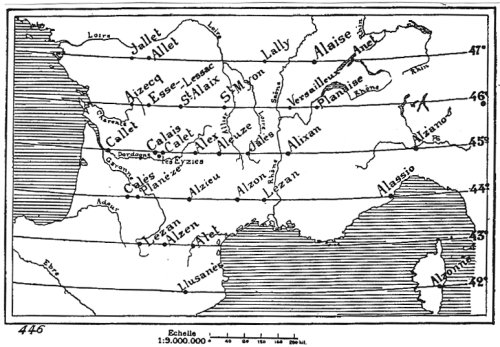|
The Salt Lines
In the 1930’s Xavier Guichard, a Frenchman, thought he had
discovered the proof that Bronze Age people were already familiar
with longitudinal and latitudinal lines (meridians and parallels) as
we use today, implying that they already divided the circle into 360
equal parts. It also implied, of course, that they knew about the
Earth circumference. A number of towns, villages and hamlets, all
bearing names apparently derived from Alesia appear to be located on these lines, as markers of this geometry.
Because the name reminded him of the Greek term Hal meaning ‘salt,’ Guichard dubbed these lines ‘Salt Lines.’
Unfortunately
for him, Guichard was slightly wrong. Salt Lines ran slightly closer
to one another that they should have in a 360-degree geometry. Sixty
years later only was Alan Butler able to determine what the problem
was with Guichard’s lines. The ancient system Guichard had
discovered worked on a 366-degree circle, nor 360. Clearly speaking,
the globe was divided into 366 equally-spaced meridians, not 360,
which explained why the lines were too close to one another.
When
I first heard about what looked like a ludicrous theory, I was quite
sceptical. And yet I was convinced Alan was right about the rest
so why not about Salt Lines? I set about verifying this daring
hypothesis, checking the geographic coordinates, not only of villages
and towns seemingly derived from Alesia, but also great cities and
capitals of antiquity at the same time. Backing my work with
probability calculations, I soon found out that, improbable thought
it might seem, these lines had indeed existed. I traced them not only
in Europe, but also on four different continents as well – in
Asia, Africa, Central America and South America. I was stunned and
electrified by such an unexpected result. Salt Lines, no doubt about
it, had been surveyed almost
all over the globe
by an ancient civilisation. And the birth of the world’s first
great civilisations – Sumer, Egypt, the Indus Valley, Greece,
the Olmecs in Mesoamerica and the pyramids of Caral in South America
all bore the fingerprint of a single geometrical system.
Let’s sum things up. Salt Lines
were of two kinds:
-
Latitudinal Salt Lines (or Salt
Parallels), deriving from the equator and running in an east-west
direction: from the North pole down to the South pole, and then
continuing on the other side of the planet back up to the North
pole, we cross 366 parallel lines in all.


-
Longitudinal Salt Lines (or Salt
Meridians), the origin (‘Greenwich’) of which was yet to
be discovered, were running in a north-south direction: there were
366 of them.

The capitals and great sanctuaries of
the world’s first great civilisations were located on the Salt
Lines. My research also showed that the river Jordan in the Middle
East, that Alan had told me was running along a Salt Line, could well
have been the Salt Lines Prime Meridian, the ‘Greenwich’
of Megalithic times. The Jordan Valley is literally packed out with
Megalithic stone circles. To cut a long story short, mathematics,
archaeology as well as chronology were all suggesting this sacred
river had been the Salt Lines Prime Meridian.
Mi
investigation finally led me to the precise discovery of Alesia,
which, according to classical Greek historian Diodorus Siculus, was
‘the hearth and mother-city of all Celtica.’ And it’s
not one but three great Alesias that I found, each one perfectly
aligned on a Salt Line running exactly 32 Megalithic degrees from the
Jordan (the central Alesia rising precisely at the midpoint between
the other two!). The central Alesia – which is not the place
where mainstream archaeology claims Caesar once defeated Gaulish
leader Vercingetorix – is located near the Burgundian village
of Guillon, France. In this place the late Bernard Fèvre,
another researcher of the 1980’s and 1990’s, had been
fighting with academics for two decades to try to prove Guillon was
the real place of the lost city.
This
is how, knowing all that, I decided to share my discoveries in a book
called Les
Lignes d’or
(‘The Golden Lines’), which refers to these incredible
Salt Lines and the immense knowledge that is attached to them.
|

